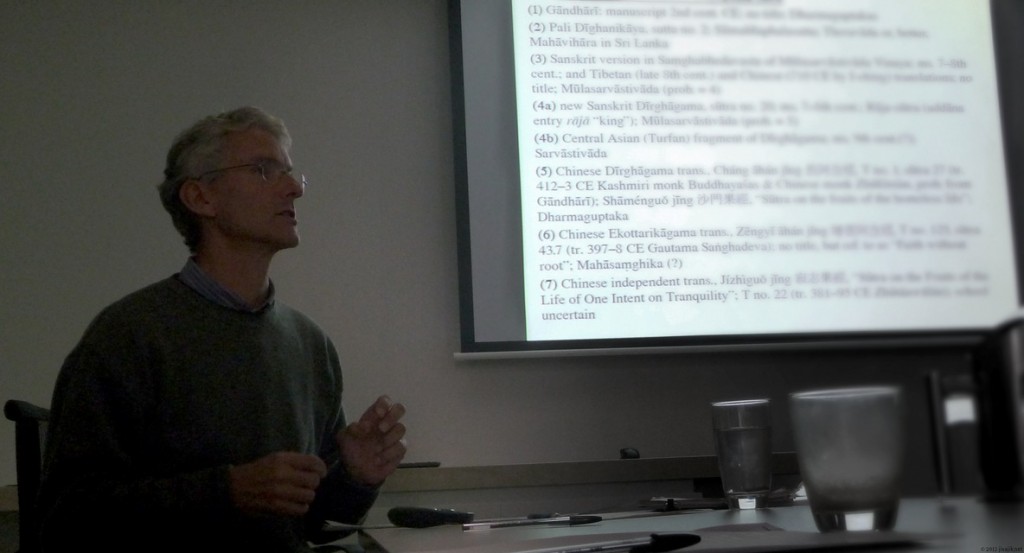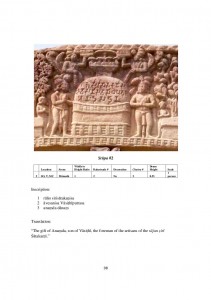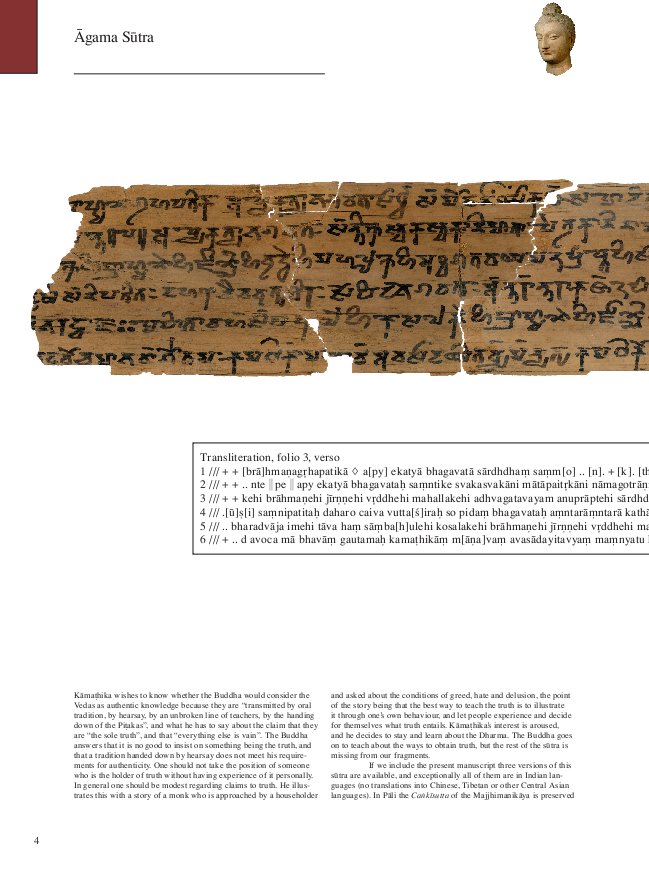Ronald M. Davidson. 2017. ‘Magicians, Sorcerers and Witches: Considering Pretantric, Non-sectarian Sources of Tantric Practices’. Religions (Special issue: Society for Tantric Studies 2016 Proceedings, eds. Glen A. Hayes & Sthaneshwar Timalsina), 8(9), 188 [33 pp.]. doi:10.3390/rel8090188 [PDF 🔓]
Schlosser (2016), On the Bodhisattva Path in Gandhāra
Schlosser, Andrea. 2013 [2016]. “On the Bodhisattva Path in Gandhāra. Edition of Fragment 4 and 11 from the Bajaur Collection of Kharoṣṭhī Manuscripts”. Freien Universität Berlin: PhD diss. 313+iv pp. URN: urn:nbn:de:kobv:188-fudissthesis000000101376-1 [PDF]
From the Abstract: This dissertation contains an edition, translation and study of two unparalleled Buddhist texts from ‘Greater Gandhāra’ (eastern Afghanistan and northwestern Pakistan), written in the Gāndhārī language and Kharoṣṭhī script and dating from the first or second century CE.
Karashima, ‘Was the Aṣṭasāhasrikā composed in Gāndhārī?’ (2013)
Seishi Karashima. ‘Was the Aṣṭasāhasrikā Prajñāpāramitā Compiled in Gandhāra in Gāndhārī?’ Annual Report of the International Research Institute for Advanced Buddhology (ARIRIAB) at Soka University for the Academic Year 2012, vol.XVI, 2013, pp.171–188. [PDF]
This is a remarkable piece of detective work and a milestone in the study of the Mahāyāna, whether or not one thinks (as I do) that Prof. Karashima’s theory nails it. Karashima’s many years of lexicographical toil seem to have finally paid off: the earliest Chinese phonetic transcriptions from the Aṣṭasāhasrikā agree most fully with the newly found Gāndhārī fragments (for which see also Strauch 2007). And that, moreover, is merely one of many compelling indicators pointing to the composition of the text in Gandhāra.
One minor comment: the image of Dharmodgata discovering the Prajñāpāramitā written on gold plates vilīnena vaidūryeṇa — in “melted” lapis, according to Karashima (p.181) — sounds excessively fantastic. The reference is to lapis lazuli pigment, well known to medievalists as ultramarine, ‘beyond the sea’ — i.e., from Afghanistan.
Stuart, The Pṛṣṭhapālasūtra of the Dīrghāgama (2013)
Daniel Malinowski Stuart. "Thinking About Cessation": The Pṛṣṭhapālasūtra of the Dīrghāgama in Context. Wiener Studien zur Tibetologie und Buddhismuskunde 79. 112 pp. ISBN-13: 978-3-902501-17-2.
Allon, ‘A Gāndhārī Śrāmaṇyaphala-sūtra’ (2013-04-05)
Mark Allon. ‘A Gāndhārī version of the Buddha’s Discourse on the Fruits of Living the Ascetic Life (Śrāmaṇyaphala-sūtra)’. Australasian Association of Buddhist Studies Victoria Seminar, 5th April 2013, Deakin Prime Campus, Melbourne.
Abstract
The Senior collection of Gandhāran Buddhist manuscripts includes a scroll which contains a Gāndhārī version of the introductory section of the Śrāmaṇyaphala-sūtra, the Buddha’s discourse to King Ajātaśatru on the benefits of living the ascetic or holy life. The appearance of a Gāndhārī version of this interesting and popular sūtra coincides with the appearance of a second Sanskrit witness of it, namely, that included in the new Dīrghāgama manuscript, which preliminary research indicates is similar to but not identical with the Sanskrit version found among the Gilgit manuscripts. We therefore now have Indic versions of the Śrāmaṇyaphala-sūtra in Gāndhārī (albeit incomplete), Pali, and Sanskrit, a Tibetan translation and four Chinese translations, which belong to a diversity of schools and originate from different times and places. Not surprisingly the Gāndhārī sūtra is not identical to any other version, but shows a complex relationship with them. In this paper I will discuss the Gāndhārī version of the sūtra and its relationship to the parallels in other languages, the possible reasons for its popularity, and the likely reasons for its inclusion in the Senior collection.

Milligan, ‘Inscribed Reliefs & Inscriptions at Sanchi’ (2010)
Milligan, Matthew David. ‘A Study of Inscribed Reliefs within the Context of Donative Inscriptions at Sanchi’. M. A. thesis, University of Texas at Austin, 2010. [official site URI / PDF]
From the abstract

Braarvig et al, Traces of Gandharān Buddhism (2010)
Jens Braarvig and Fredrik Liland, with contributions by Jens-Uwe Hartmann, Kazunobu Matsuda, Richard Salomon, and Lore Sander. Traces of Gandharān Buddhism. An Exhibition of Ancient Buddhist Manuscripts in the Schøyen Collection. Oslo: Hermes Publishing, in collaboration with Amarin Printing and Publishing Public Co. Ltd, Bangkok. 2010. xxxiv+101pp. [PDF (80 MB)].
This lavishly illustrated — and even more importantly, thoroughly researched — catalogue, published to accompany an exhibition of Afghan Buddhist manuscripts in Thailand, will surely be of interest to any serious scholar of Buddhism. Braarvig notes: “it is thus an important task to help preserve this dharmakāya [manuscript heritage] of the Buddha”. (One could add that Thailand, where a formerly practiced Sanskritic tradition has been completely lost, is probably not the place to find a receptive audience for such sentiments.)
Luczanits’ ITBA
Christian Luczanits. 2014&ndash. ‘Homepage of Christian Luczanits’ [before 2014: Indian and Tibetan Buddhist Art (ITBA) at the University of Vienna]. http://www.luczanits.net.
NB: a large and well-documented collection of photographs from sites in the Himalayas and South Asia including Alchi, Ladakh, Kanganhalli, Kinnaur and Lahaul-Spiti.


